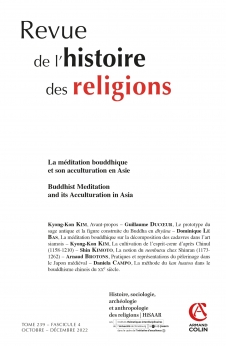
REVUE DE L'HISTOIRE DES RELIGIONS (4/2022)
Pour acheter ce numéro, contactez-nous
Recevez les numéros de l'année en cours et accédez à l'intégralité des articles en ligne.
La méthode du kan huatou (« pénétrer le mot-clé ou la phrase critique ») représente l’un des nombreux exemples de sinisation du bouddhisme. Il existe de nombreuses études, tant sur la formulation de cette méthode et sa diffusion en Chine à partir du XIIe siècle que sur sa fortune au Japon, au Vietnam et surtout en Corée, où elle est devenue la forme principale de méditation. Néanmoins, son héritage en Chine à l’époque moderne et contemporaine n’a jamais été considéré. Cet article revient d’abord sur l’histoire et le fonctionnement de la méthode du kan huatou, avant d’en montrer brièvement la continuité et l’importance en Chine au xxe siècle et jusqu’à aujourd’hui. La traduction annotée des instructions sur le kan huatou délivrées par le maître Xuyun (ca. 1864‑1959) en 1950 complétera cet aperçu en apportant un témoignage sur l’utilisation de cette méthode dans les monastères Chan.
The kan huatou (“inspecting the critical phrase”) method of meditation represents one of the many examples of the sinicization of Buddhism. Many studies exist on the formulation of this method and its spread in China since the 12th century, as well as on how it fared in Japan, Vietnam and especially Korea, where it remains the main form of meditation to this day. However, its legacy in modern and contemporary China has never been considered. After outlining the history and functioning of the kan huatou method, this article will briefly show its continuity and importance in China in the 20th and 21st centuries. The annotated translation of the religious instructions on kan huatou delivered by Master Xuyun (ca. 1864‑1959) in 1950 will complete this overview by providing a first-hand account of the use of this method of practice in monasteries of the Chan tradition.

